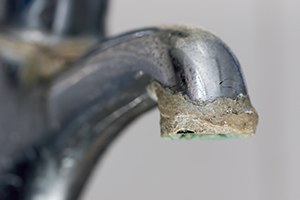Scale deposits are a typical indicator of hard water.
Hard water (or water hardness) is a common quality of water which contains dissolved compounds of calcium and magnesium and, sometimes, other divalent and trivalent metallic elements.

The term hardness was originally applied to waters that were hard to wash in, referring to the soap wasting properties of hard water. Hardness prevents soap from lathering by causing the development of an insoluble curdy precipitate in the water; hardness typically causes the buildup of hardness scale (such as seen in cooking pans). Dissolved calcium and magnesium salts are primarily responsible for most scaling in pipes and water heaters and cause numerous problems in laundry, kitchen, and bath. Hardness is usually expressed in grains per gallon (or ppm) as calcium carbonate equivalent.
What is Soft Water?
Soft water is defined by American National Standards NSF/ANSI 44 and NSF/ANSI 330 as water containing <1 grain of hardness per gallon (or <17.1 mg/L hardness).
Symptoms of Hard Water include:
- Stiff, dingy laundry
- Mineral deposits on dishes and glassware
- High soap usage & need for fabric softeners
- Extra work to remove soap curd on bathtubs & shower stalls
- High energy costs, possibly due to scale build-up in pipes and on appliances
- Scale build up in sinks, tubs, faucets & appliances
Click here for national data on hard water occurrence from the U.S. Geological Survey.
Water treatment can improve hardness issues.
Scale deposits from hardness buildup affects fixtures and appliances found throughout the entire home or business. For this reason, hardness is typically addressed with treatment of water for the whole house or building rather than just at a specific faucet.
Antiscaling treatment devices aim to reduce or prevent certain scale deposits that are normal to hard water behavior. This includes technologies such as physical water treatment devices, as well as sacrificial media. These technologies may provide a measurable reduction in hardness depending on the measurement method applied by conversion of calcium and magnesium ions to a precipitate form, but do not provide a reduction of total calcium or magnesium content of the treated stream nor are they proven to achieve soft water (less than 1.0 grain per gallon/<17.1 milligrams per liter or parts per million of total hardness).
A sacrificial media treatment device releases a chemical such as citric acid or phosphate into the water to discourage the formation of scale.
A physical water treatment device modifies the properties of water by physical means as opposed to chemical or mechanical means. Physical water treatment devices do not use, nor do they impart significant levels of any chemical substance(s) to the water stream being treated. Physical water treatment devices use a range of processes, including media induced precipitation, magnetic, electronic, electrostatic, and electromagnetic technologies.
While there is research into the performance of many of these devices, there remains some areas of the technologies that are less understood. Varying water quality in homes throughout the country also make it more difficult to predict the performance of antiscaling devices in any given residential setting. Consumers should investigate their system selection prior to making a purchase, and as with all water treatment devices, look for antiscaling water treatment systems that have been demonstrated to meet performance, structural integrity and safety according to a published standard by an accredited third-party product certifier.
Click here to find products certified by WQA for hardness reduction (certified to NSF/ANSI Standard 44).
Click here to find a water treatment provider who can help.
